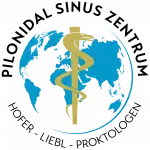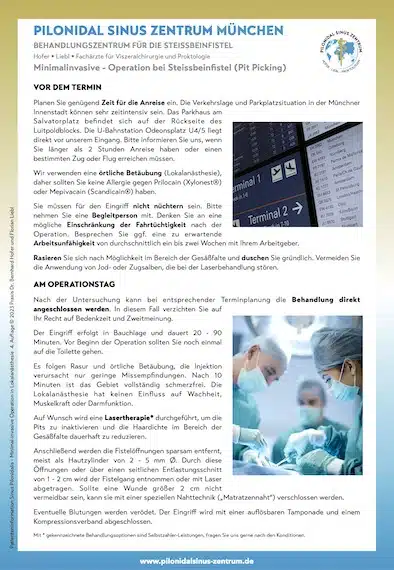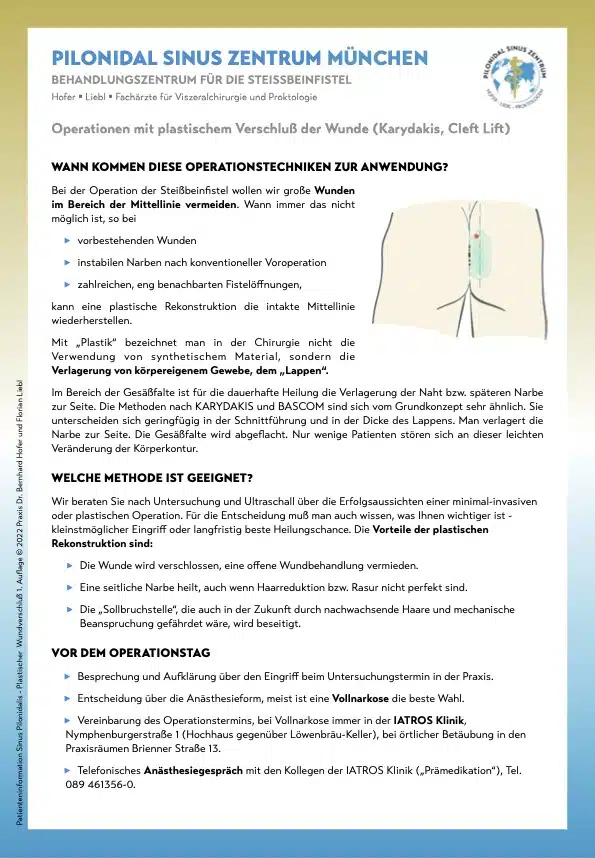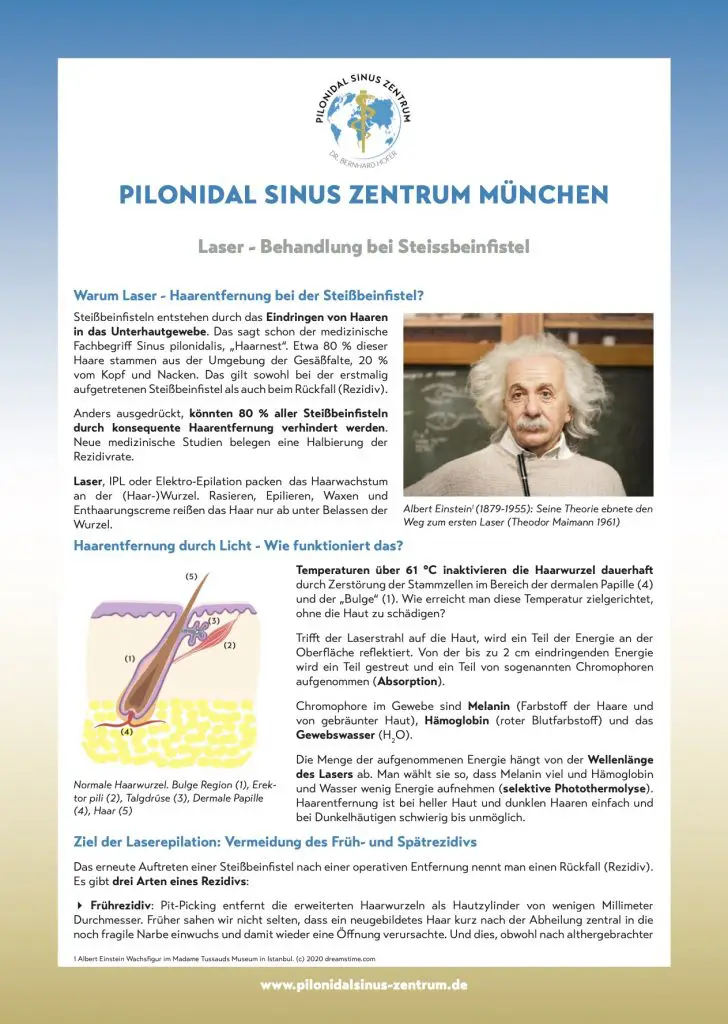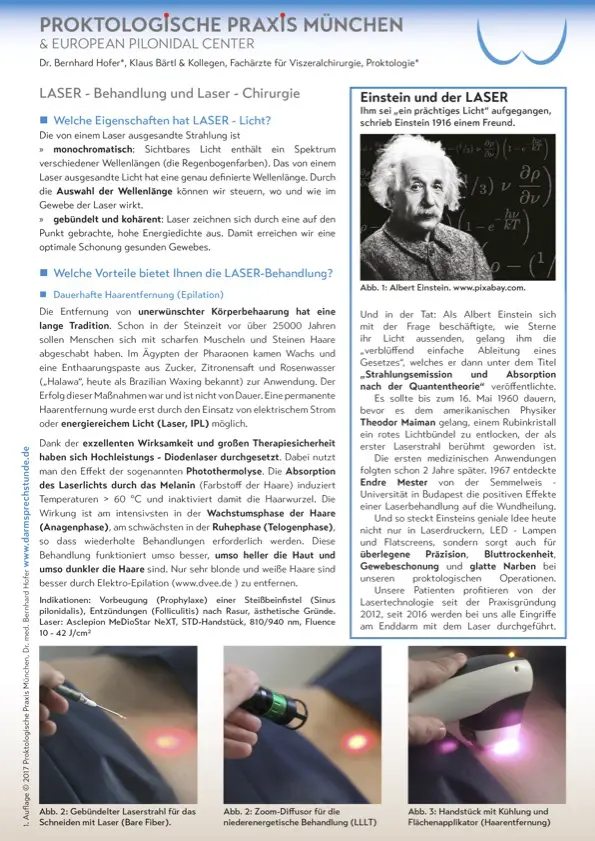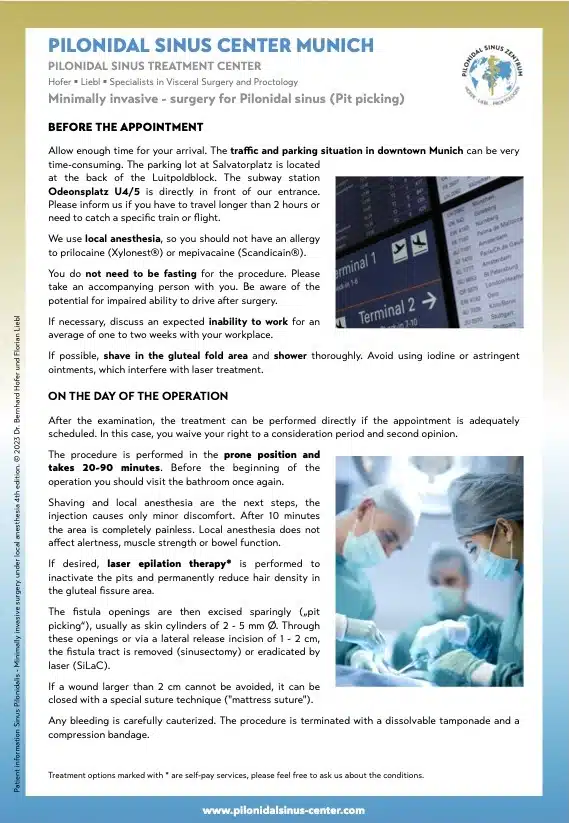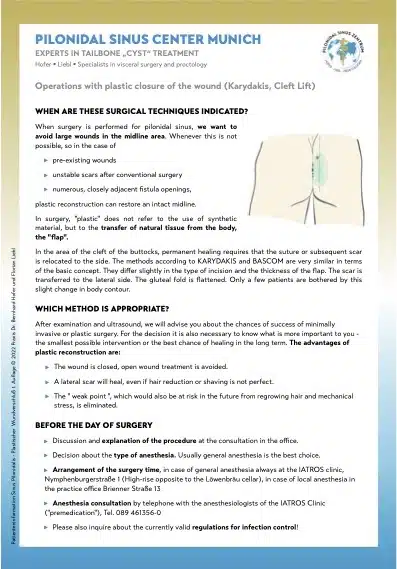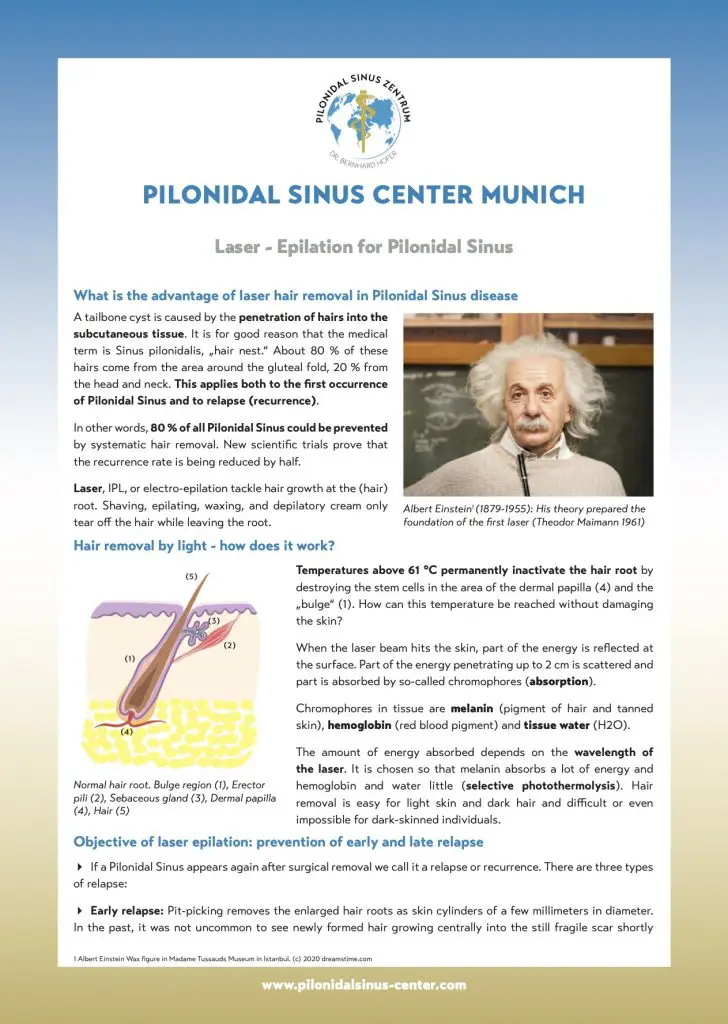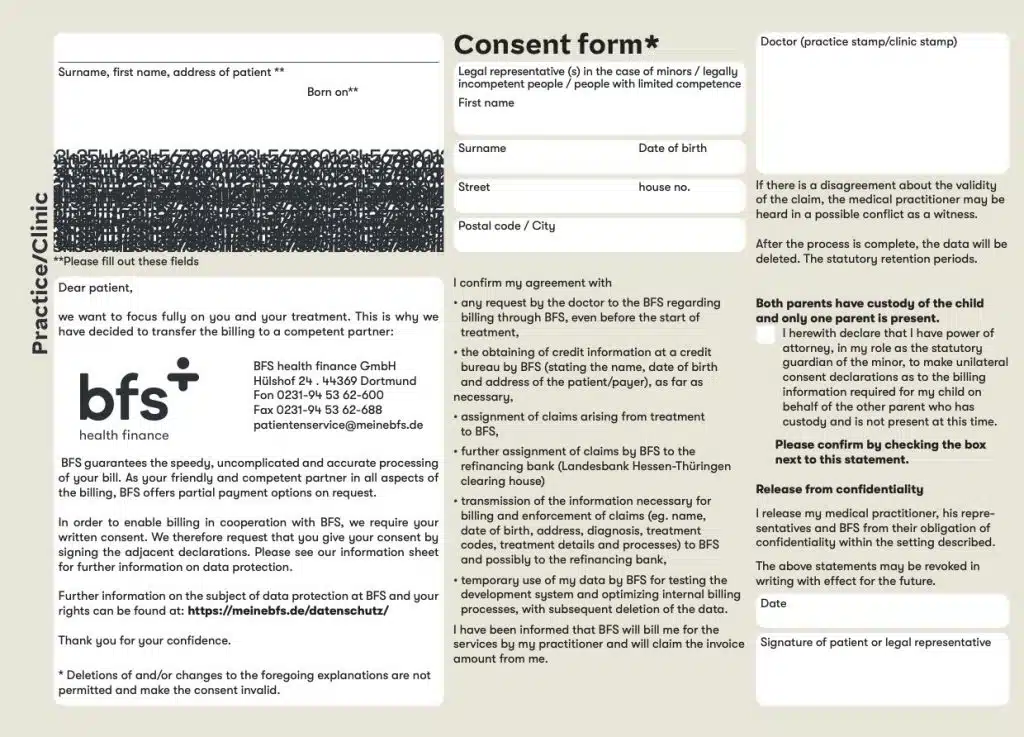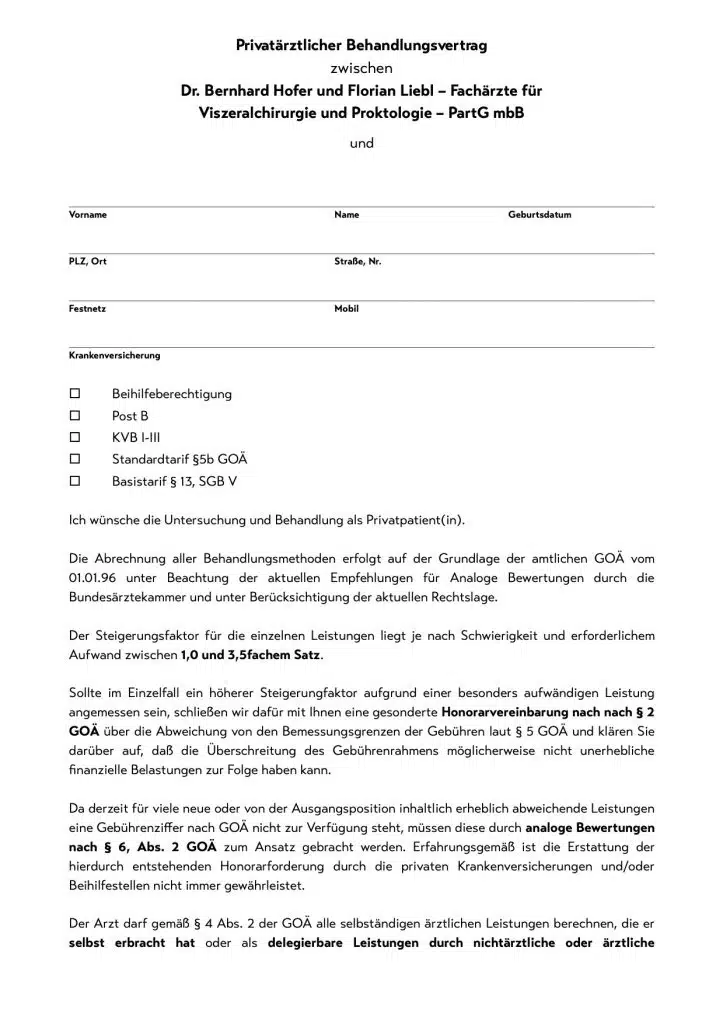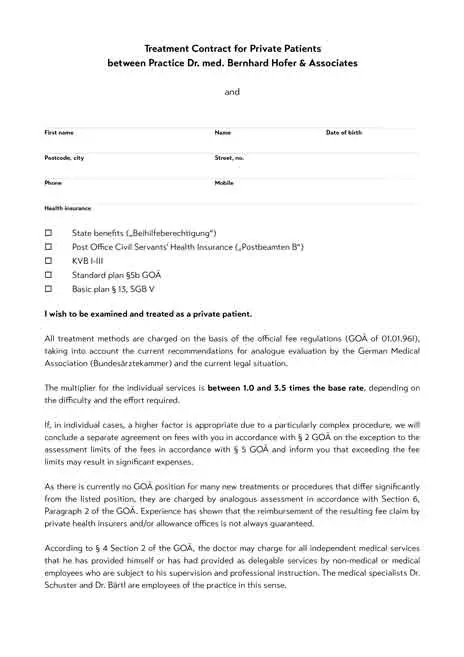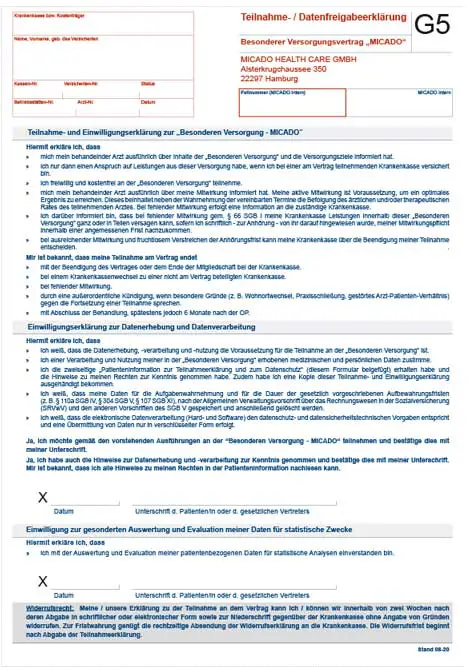Herzlich willkommen auf unserem umfassenden Informationsportal zum Thema Steißbeinfistel und deren Behandlung durch modernste minimal-invasive Operationstechniken und Lasertherapie. Wir freuen uns, Sie hier begrüßen zu dürfen und möchten Ihnen mit unseren kompakten Informationsbroschüren eine schnelle Möglichkeit bieten, Ihr Verständnis für dieses medizinische Thema zu vertiefen und Sie auf Ihrem Weg zur Genesung bestmöglich zu unterstützen.
Darüber hinaus bieten wir Ihnen die Möglichkeit, wichtige Formulare unserer Praxis herunterzuladen, um Ihren Besuch bei uns so reibungslos wie möglich zu gestalten.
Wenn Sie weitere Fragen haben oder einen Termin vereinbaren möchten, zögern Sie bitte nicht, uns zu kontaktieren.
Info Flyer Praxis deutsch
Info Flyer Praxis englisch
Formulare / Forms
Literaturverzeichnis
Steißbeinfistel allgemein, Wundversorgung
Ardelt, M., Dittmar, Y., Kocijan, R., Rödel, J., Schulz, B., Scheuerlein, H., & Settmacher, U. (2016). Microbiology of the infected recurrent sacrococcygeal pilonidal sinus. International Wound Journal, 13(2), 231-237.
Armstrong, D. G., Bohn, G., Glat, P., Kavros, S. J., Kirsner, R., Snyder, R., & Tettelbach, W. (2015). Expert Recommendations for the Use of Hypochlorous Solution: Science and Clinical Application. Ostomy/wound management, 61(5), S2–S19.
Aysan, E., Ilhan, M., Bektas, H., Kaya, E. A., Sam, B., Buyukpinarbasili, N., & Muslumanoglu, M. (2013). Prevalence of sacrococcygeal pilonidal sinus as a silent disease. Surgery today, 43(11), 1286–1289.
Bascom, J. (1980). Pilonidal disease: origin from follicles of hairs and results of follicle removal as treatment. Surgery, 87(5), 567-572.
Bosche, F., Luedi, M., Zypen, D., Moersdorf, P., Krapohl, B., & Doll, D. (2017). The Hair in the Sinus: Sharp-Ended Rootless Head Hair Fragments can be Found in Large Amounts in Pilonidal Sinus Nests. World Journal of Surgery, 42(2), 567-573.
Carter, D., Blair, S., Cokcetin, N., Bouzo, D., Brooks, P., Schothauer, R., & Harry, E. (2016). Therapeutic Manuka Honey: No Longer So Alternative. Frontiers in Microbiology, 7,
Cubukçu, A., Carkman, S., Gönüllü, N. N., Alponat, A., Kayabaşi, B., & Eyüboğlu, E. (2001). Lack of evidence that obesity is a cause of pilonidal sinus disease. The European journal of surgery = Acta chirurgica, 167(4), 297–298.
Curtis, A. (2018). Why use manuka honey?. The Veterinary Nurse, 9(10), 513-524.
Dahl, H. D., & Henrich, M. H. (1992). Licht- und rasterelektronenmikroskopische Untersuchungen zur Pathogenese des Sinus pilonidalis und der Analfistel [Light and scanning electron microscopy study of the pathogenesis of pilonidal sinus and anal fistula]. Langenbecks Archiv fur Chirurgie, 377(2), 118–124
Davis, K. A., Mock, C. N., Versaci, A., & Lentrichia, P. (1994). Malignant degeneration of pilonidal cysts. The American surgeon, 60(3), 200–204.
Delshad, H., Dawson, M., Melvin, P., Zotto, S., & Mooney, D. (2019). Pit-picking resolves pilonidal disease in adolescents. Journal of pediatric surgery, 54(1), 174-176.
Dill D. (2013) Herausforderungen in der Nagelchirurgie. Eingewachsene Nägel: hohes Rezidivrisiko auch bei OP. Symposium „Haare und Nägel“. ästhetische dermatologie & kosmetologie volume 5, page15
Doll, D., Bosche, F., Hauser, A., Moersdorf, P., Sinicina, I., Grunwald, J., Reckel, F., & Luedi, M. (2018). The presence of occipital hair in the pilonidal sinus cavity—a triple approach to proof. International Journal of Colorectal Disease, 33(5), 567-576.
Fernández, L. G., Matthews, M. R., & Seal, L. (2020). Intraabdominal Lavage of Hypochlorous Acid: A New Paradigm for the Septic and Open Abdomen. Wounds : a compendium of clinical research and practice, 32(4), 107–114.
(2011). Fluid Lavage of Open Wounds (FLOW): A Multicenter, Blinded, Factorial Pilot Trial Comparing Alternative Irrigating Solutions and Pressures in Patients With Open Fractures. The Journal of Trauma: Injury, Infection, and Critical Care, 71(3), 596-606.
Girma, A., Seo, W., & She, R. (2019). Antibacterial activity of varying UMF-graded Manuka honeys. PLoS ONE, 14(10),
Gold, M. H., Andriessen, A., Bhatia, A. C., Bitter, P., Jr, Chilukuri, S., Cohen, J. L., & Robb, C. W. (2020). Topical stabilized hypochlorous acid: The future gold standard for wound care and scar management in dermatologic and plastic surgery procedures. Journal of cosmetic dermatology, 19(2), 270–277.
Harriott, M. M., Bhindi, N., Kassis, S., Summitt, B., Perdikis, G., Wormer, B. A., Rankin, T. M., Kaoutzanis, C., Samaha, M., Stratton, C., & Schmitz, J. E. (2019). Comparative Antimicrobial Activity of Commercial Wound Care Solutions on Bacterial and Fungal Biofilms. Annals of plastic surgery, 83(4), 404–410.
Jackman, R. (1962). The etiology of pilonidal sinus. Diseases of the Colon & Rectum, 5(1), 28–36-28&ndash-ndash;36-28–36.
Kucera, J., Coley, I., O’Hara, S., Kosnik, E., & Coley, B. (2014). The simple sacral dimple: diagnostic yield of ultrasound in neonates. Pediatric Radiology, 45(2), 211-216.
Lord, P. (1975). Anorectal problems: Etiology of pilonidal sinus. Diseases of the Colon & Rectum, 18(8), 661–664
Main, R. (2008). Should chlorhexidine gluconate be used in wound cleansing?. Journal of Wound Care, 17(3), 112-114.
Martino, A., De Martino, C., Pisapia, A., Maharajan, G., & Evangelista, M. (2011). Squamous-cell carcinoma arising in a pilonidal sinus: case report and review of the literature. BMC Geriatrics, 11(Suppl1), A28-A28.
Mayo, O.H. (1833). Observations on injuries and disease of rectum. Burgess and Hill, London, pp 45 – 46
Midtgaard, H. G., & Eiholm, S. (2012). Pilonidalsygdom er en benign lidelse [Pilonidal disease is a benign condition]. Ugeskrift for laeger, 174(46), 2855–2859.
Ommer, A., Berg, E., Breitkopf, C., Bussen, D., Doll, D., Fürst, A., Herold, A., Hetzer, F., Jacobi, T., Krammer, H., Lenhard, B., Osterholzer, G., Petersen, S., Ruppert, R., Schwandner, O., Sailer, M., Schiedeck, T., Schmidt-Lauber, M., Stoll, M., Strittmatter, B., & Iesalnieks, I. (2014).S3-Leitlinie: Sinus pilonidalis. coloproctology, 36(4), 272-322.
Page, B. (1969). The entry of hair into a pilonidal sinus. British Journal of Surgery, 56(1), 32-32
Karydakis, G. (1974). New approach to the problem of pilonidal sinus.. Lancet (London, England), 2(7843), 1414-5.
Søndenaa, K., Andersen, E., Nesvik, I., & Søreide, J. (2004). Patient characteristics and symptoms in chronic pilonidal sinus disease. International Journal of Colorectal Disease, 10(1), 39-42.
Tezel, E. (2007). A new classification according to navicular area concept for sacrococcygeal pilonidal disease. Colorectal Disease, 9(6)
Tezel, E., Leventoglu, S., & Wysockı, A. (2019). Trends toward atailored approach for pilonidal sinus disease. coloproctology, 41(2), 121-126.
Wilson, P., Hayes, E., Barber, A., & Lohr, J. (2016). Screening for Spinal Dysraphisms in Newborns With Sacral Dimples. Clinical Pediatrics, 55(11), 1064-1070.
Yildiz, T., Elmas, B., Yucak, A., Turgut, H. T., & Ilce, Z. (2017). Risk Factors for Pilonidal Sinus Disease in Teenagers. Indian journal of pediatrics, 84(2), 134–138.
Ypsilantis, E., Carapeti, E., & Chan, S. (2015). The use of topical 10% metronidazole in the treatment of non-healing pilonidal sinus wounds after surgery. International Journal of Colorectal Disease, 31(3), 765-767.
Haarentfernung
Alijanpour, R., & Aliakbarpour, F. (2017). A randomized clinical trial on the comparison between hair shaving and snipping prior to laser hair removal sessions in women suffering from hirsutism. Journal of Cosmetic Dermatology, 16(1), 70-75.
Fernandez, A., França, K., Chacon, A., & Nouri, K. (2013). From flint razors to lasers: a timeline of hair removal methods. Journal of Cosmetic Dermatology, 12(2), 153-162.
Kiene, J., Maiman, R., & DeKlotz, C. (2020). Severe irritant reaction following sequential waxing and use of a chemical depilatory cream in an adolescent. Pediatric Dermatology, 37(1), 190-191.
Lim, V., Simmons, B., Maranda, E., Afifi, L., Kallis, P., & Jimenez, J. (2016). Sugaring—Modern Revival of an Ancient Egyptian Technique for Hair Removal. JAMA Dermatology, 152(6), 660-660.
Laser
Bringmann, W.: Low Level Laser Therapie. 2015, Füchtenbusch-Verlag Starnberg (Lehrbuch)
Cartlidge, E. (2007). Theodore Maiman 19272007. Physics World, 20(6)
Conroy, F. J., Kandamany, N., & Mahaffey, P. J. (2008). Laser depilation and hygiene: preventing recurrent pilonidal sinus disease. Journal of plastic, reconstructive & aesthetic surgery : JPRAS, 61(9), 1069–1072.
Maiman, T.H. (1960): Stimulated Optical Radiation in Ruby. Nature, No. 4736
Raulin C. and Karsai S. (eds.), Laser and IPL Technology in Dermatology and Aesthetic Medicine , DOI: 10.1007/978-3-642-03438-1_2, © Springer- Verlag Berlin Heidelberg 2011
Plastische Verschlußtechniken
Bascom, J., & Bascom, T. (2002). Failed Pilonidal Surgery: New Paradigm and New Operation Leading to Cures. Archives of Surgery, 137(10), 1146-1150.
Bozkurt, M., & Tezel, E. (2005). Management of pilonidal sinus with the limberg flap. Diseases of the Colon & Rectum, 41(6), 775-777
Favuzza, J., Brand, M., Francescatti, A., & Orkin, B. (2015). Cleft lift procedure for pilonidal disease: technique and perioperative management. Techniques in Coloproctology, 19(8), 477-482.
Maruyama, Y. (2001). Sacral Adipofascial Turn‐Over Flap for the Excisional Defect of Pilonidal Sinus. Plastic & Reconstructive Surgery, 108(7), 2006–2010-2006.
Petersen, S., Aumann, G., Kramer, A., Doll, D., Sailer, M., & Hellmich, G. (2007). Short-term results of Karydakis flap for pilonidal sinus disease. Techniques in Coloproctology, 11(3), 235-240.
Wysocki, A.P., & Doll, .D. (2019). Missing Points in Pilonidal Disease: Management. Diseases of the Colon & Rectum, 62(4),
FiLaC / SiLaC/EPSiT
Dessily, M., Dziubeck, M., Chahidi, E., & Simonelli, V. (2019). The SiLaC procedure for pilonidal sinus disease: long-term outcomes of a single institution prospective study. Techniques in Coloproctology, 23(12), 1133-1140.
Giamundo P, Geraci M, Tibaldi L, Valente M (2013) Closure of fistula-in-ano with laser—FiLaC™: an effective novel sphincter-saving procedure for complex disease. Colorectal Dis 16:110–115
Meinero, P., Mori, L., & Gasloli, G. (2013). Endoscopic pilonidal sinus treatment (E.P.Si.T.). Techniques in Coloproctology, 18(4), 389-392.
Milone, M., Musella, M., Di Spiezio Sardo, A., Bifulco, G., Salvatore, G., Sosa Fernandez, L., Bianco, P., Zizolfi, B., Nappi, C., & Milone, F. (2014). Video-assisted ablation of pilonidal sinus: A new minimally invasive treatment—A pilot study. Surgery, 155(3), 562-566.
Wilhelm, A. (2011). A new technique for sphincter-preserving anal fistula repair using a novel radial emitting laser probe. Techniques in Coloproctology, 15(4), 445-449.
Behandlung ohne Operation
Allegranzi, B., Bischoff, P., de Jonge, S., Kubilay, N. Z., Zayed, B., Gomes, S. M., Abbas, M., Atema, J. J., Gans, S., van Rijen, M., Boermeester, M. A., Egger, M., Kluytmans, J., Pittet, D., Solomkin, J. S., & WHO Guidelines Development Group (2016). New WHO recommendations on preoperative measures for surgical site infection prevention: an evidence-based global perspective. The Lancet. Infectious diseases, 16(12), e276–e287.
Armstrong, J., & Barcia, P. (1994). Pilonidal Sinus Disease: The Conservative Approach. Archives of Surgery, 129(9), 914-918.
Arslan NC, Degirmenci AK, Ozdenkaya Y, Terzi C. Wound Irrigation with Chlorhexidine Gluconate Reduces Surgical Site Infection in Pilonidal Disease: Single-Blind Prospective Study. Surg Infect (Larchmt). 2020 Mar;21(2):143-149.
Berríos-Torres, S., Umscheid, C., Bratzler, D., Leas, B., Stone, E., Kelz, R., Reinke, C., Morgan, S., Solomkin, J., Mazuski, J., Dellinger, E., Itani, K., Berbari, E., Segreti, J., Parvizi, J., Blanchard, J., Allen, G., Kluytmans, J., Donlan, R., & Schecter, W. (2017). Centers for Disease Control and Prevention Guideline for the Prevention of Surgical Site Infection, 2017. JAMA Surgery, 152(8), 784-791.
Breidablik, H., Lysebo, D., Johannessen, L., Skare, Andersen, J., & Kleiven, O. (2020). Effects of hand disinfection with alcohol hand rub, ozonized water, or soap and water: time for reconsideration? The Journal of Hospital Infection, 105(2), 213-215.
Cherian, P., Gunson, T., Borchard, K., Tai, Y., Smith, H., & Vinciullo, C. (2013). Oral antibiotics versus topical decolonization to prevent surgical site infection after Mohs micrographic surgery–a randomized, controlled trial. Dermatologic surgery : official publication for American Society for Dermatologic Surgery [et al.], 39(10), 1486–1493.
Cooper R. A. (2007). Iodine revisited. International wound journal, 4(2), 124–137. https://doi.org/10.1111/j.1742-481X.2007.00314.x
Castelain F, Girardin P, Moumane L, Aubin F, Pelletier F. Anaphylactic reaction to povidone in a skin antiseptic. Contact Dermatitis. 2016 Jan;74(1):55-6. doi: 10.1111/cod.12473. PMID: 26690279.
Edmiston, C., & Leaper, D. (2017). Should preoperative showering or cleansing with chlorhexidine gluconate (CHG) be part of the surgical care bundle to prevent surgical site infection?. Journal of Infection Prevention, 18(6), 311-314.
Fernandez, R., & Griffiths, R. (2012). Water for wound cleansing. The Cochrane database of systematic reviews, (2), CD003861
Harris, C., Sibbald, R., Mufti, A., & Somayaji, R. (2016). Pilonidal Sinus Disease: 10 Steps to Optimize Care. Advances in Skin & Wound Care, 29(10), 469-478.
Le Pabic F, et al. First case of anaphylaxis to iodinated povidone. Allergy 58: 826-827, No. 8, Aug 2003 – France
Liu, J., Werner, J., Kirsch, T., Zuckerman, J., & Virk, M. (2018). Cytotoxicity evaluation of chlorhexidine gluconate on human fibroblasts, myoblasts, and osteoblasts. Journal of Bone and Joint Infection, 3(4), 165-172.
McDonnell, G., & Russell, A. D. (1999). Antiseptics and disinfectants: activity, action, and resistance. Clinical microbiology reviews, 12(1), 147–179.
Okano, M., Nomura, M., Hata, S., Okada, N., Sato, K., Kitano, Y., Tashiro, M., Yoshimoto, Y., Hama, R., & Aoki, T. (1989). Anaphylactic Symptoms due to Chlorhexidine Gluconate. Archives of Dermatology, 125(1), 50-52.
Willy, C., Scheuermann-Poley, C., Stichling, M., von Stein, T., & Kramer, A. (2017). Bedeutung von Wundspüllösungen und Flüssigkeiten mit antiseptischer Wirkung in Therapie und Prophylaxe : Update 2017. Der Unfallchirurg, 120(7), 549–560.
Pit Picking
Bosche, F., Luedi, M., Zypen, D., Moersdorf, P., Krapohl, B., & Doll, D. (2017). The Hair in the Sinus: Sharp-Ended Rootless Head Hair Fragments can be Found in Large Amounts in Pilonidal Sinus Nests. World Journal of Surgery, 42(2), 567-573.
Buie, L. (1944). Jeep Disease. Southern Medical Journal, 37(2), 103-109-103-109.
Chintapatla, S., Safarani, N., Kumar, S., & Haboubi, N. (2003). Sacrococcygeal pilonidal sinus: historical review, pathological insight and surgical options. Techniques in Coloproctology, 7(1), 3-8.
Hodge, R.M. (1880). Pilonidal Sinus. Boston Med Surg J 103:485-6, 493, 544
Multani, J., & Kives, S. (2015). Dermoid cysts in adolescents. Current Opinion in Obstetrics and Gynecology, 27(5), 315-319.
Palmer, W. (1959). Pilonidal disease A new concept of pathogenesis. Diseases of the Colon & Rectum, 2(3), 303–307-303&ndash-ndash;307-303–307.
Page, B. (1969). The entry of hair into a pilonidal sinus. British Journal of Surgery, 56(1), 32-32.
Patey D.H., Scarff R.W. (1946): Pathology of postanal pilonidal sinus; its bearing on treatment. Lancet. 1946 Oct 5;2(6423):484-6.
Bascom, J. (1983). Pilonidal disease Long‐term results of follicle removal. Diseases of the Colon & Rectum, 26(12), 800–807-800&ndash-ndash;807-800–807.
Colov, E., & Bertelsen, C. (2013). Short convalescence and minimal pain after out-patient Bascom’s pit-pick operation.. Danish medical bulletin, 58(12), A4348A4348-AA4348.
Ehrl, D., Choplain, C., Heidekrueger, P., Erne, H., Rau, H., & Broer, P. (2017). Treatment Options for Pilonidal Disease.. The American surgeon, 83(5), 453-457.
Iesalnieks, I., Deimel, S., Kienle, K., Schlitt, H., & Zülke, C. (2011). Pit-picking-Operation bei Patienten mit Sinus pilonidalis. Der Chirurg, 82(10), 927-931.
Iesalnieks, I., Deimel, S., & Schlitt, H. (2014). „Pit-picking“-Operation bei Patienten mit Sinus pilonidalis. Der Chirurg, 86(5), 482-485.
Lord, P., & Millar, D. (1965). Pilonidal sinus: A simple treatment. British Journal of Surgery, 52(4), 298-300.
Oliveira, A., Barroso, C., Osório, A., & Correia-Pinto, J. (2019). Minimally Invasive Surgical Treatment of Pilonidal Disease: Mid-Term Retrospective Analysis of a Single Center. Frontiers in Pediatrics, 7,
Rauchen
Johnson, E. (2018). Expert Commentary on Pilonidal Disease: Management and Definitive Treatment. Diseases of the Colon & Rectum, 61(7), 777-779.
Tiwari, R., Sharma, V., Pandey, R., & Shukla, S. (2020). Nicotine Addiction: Neurobiology and Mechanism. Journal of Pharmacopuncture, 23(1), 1-7.
Akne inversa
Saunte, D., & Jemec, G. (2017). Hidradenitis Suppurativa. JAMA, 318(20), 2019-2032.
Ayurvedische Medizin
DR. BERNHARD HOFER & FLORIAN LIEBL
Fachärzte für Viszeralchirurgie und Proktologie – PartG mbB
Brienner Str. 13, D-80333 München
- info@darmsprechstunde.de
- Montag - Freitag: 08.00 - 13.00 und 14.00 - 18.00
- und nach Vereinbarung
- Samstag, Sonntag, Feiertag : geschlossen
- Beachten Sie auch unsere Hinweise im Titel dieser Website und auf unserer Telefonansage.

Mit dem Laden der Karte akzeptieren Sie die Datenschutzerklärung von Google.
Mehr erfahren
© 2024 Proktologische Praxis München
